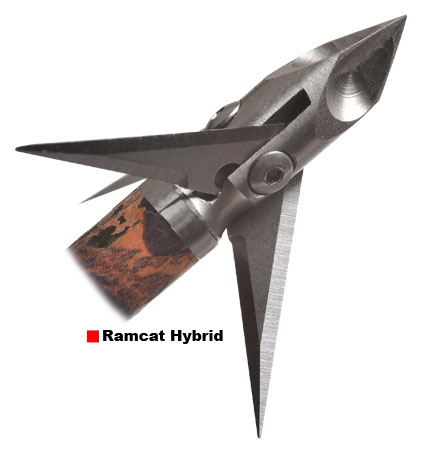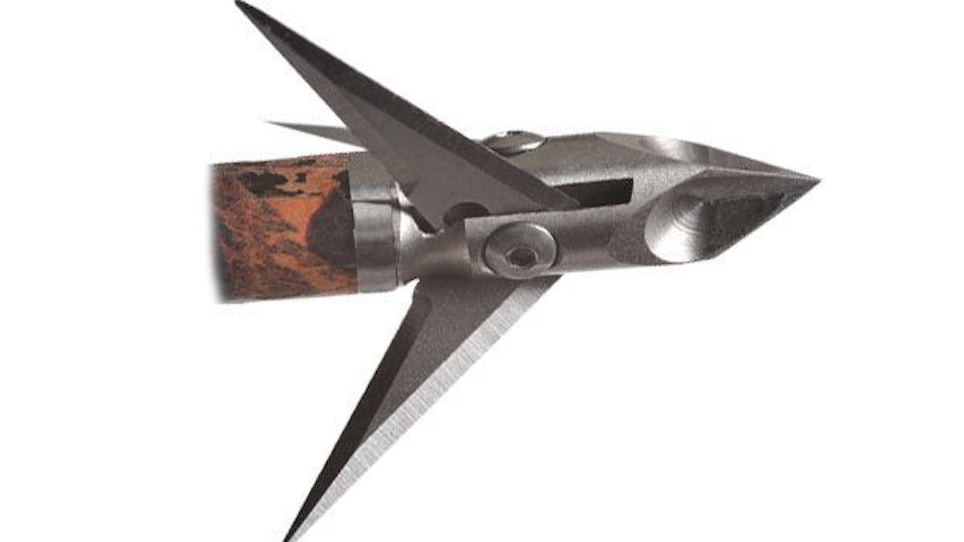**Return to AB.com Product Profiles
 Brett Fulton, the president of Fulton Precision Archery, delights in shooting his broadhead—the Ramcat Hybrid Fixed Blade—at the Archery Trade Show.
Brett Fulton, the president of Fulton Precision Archery, delights in shooting his broadhead—the Ramcat Hybrid Fixed Blade—at the Archery Trade Show.
In side-by-side test shots through ballistic gelatin—some slabs inset with a section of plywood to simulate bone—Fulton demonstrates how deeply his Ramcat broadhead penetrates versus the competition. It was such an effective demonstration that in less than two years (Ramcat’s first show was 2010) Precision Shooting Equipment (PSE) inked a deal to have its regional sales managers promote Fulton’s broadhead to archery pro shops, distributors, sporting goods stores, and buying groups nationwide and internationally.
But what about that description, a “hybrid fixed blade.” What is that?
“This head has so many features I don’t know where to start,” Fulton says. Basically “hybrid fixed blade” refers to the characteristic that makes this three-blade head lethal. The Ramcat’s replaceable stainless steel blades are solid—without cut-outs or vents, and they are held in the ferrule independently by small, .050-inch screws. They can be changed or tightened using the smallest Allen wrench in a set. (In fact, after shooting them a few times it isn’t a bad idea to make sure they are tight and perfectly positioned, says Fulton.)
Of course “in position” for Ramcat blades is offset or cantilevered to the vertical plane of the arrow and ferrule. This design promotes arrow rotation and stabilization, and because the blades are aligned with the structural ribs of the tip, they fly silently, in what Fulton calls “stealth mode.”
“Ramcat’s .032-inch blades have a ‘stealth’ design,” Fulton says, and yet what make this 100-grain head unique are fore-and-aft blade sharpening—and its unique swiveling ability. Blades are honed to industrial sharpness on their leading or cutting edge and also sharpened on the rear or trailing edge—something to be aware of whenever you and your customers handle them.
The practical reason for rear sharpening is to create a “back-cut” if the head—“for some reason,” says Fulton—does not achieve a complete pass-through. If a big game animal attempts to pull the arrow out or if it drags on brush as it runs, the blades rotate forward on an internal cam and the initial 1 3/8-inch cut becomes a much wider 1 ¾-inch cut when it is extracted.”
Thus Fulton says, “No pass-through, no problem.”
Assisted by his wife, Chris, Brett Fulton experimented with a line of “Smoke Broadheads” before settling on the Ramcat blueprint. “I’ve been bowhunting for 38 years,” he says, “and I wanted the ultimate broadhead, the one that would truly fly like a field point. The Ramcat does that.
“Think of it this way. In the early days of the compound when you used to still see a lot of recurves, we were lucky to actually shoot 180-200 feet per second in the field and big, heavy structural heads were fine with that setup. But today’s gear is more sophisticated, more critical. The average vertical bow is easily capable of shooting 300 feet per second and the basic crossbow to almost 400. Why would you want to trust that one great trophy shot each year to 30- to 50-year-old technology? You have a modern, high-tech bow and arrows. You ought to equip them with a modern, high-tech head like the Ramcat.”
According to Fulton it isn’t just the blade that makes the Ramcat special. The one-piece stainless steel tip and ferrule are purposefully engineered to maximize penetration and to work with his blade design as a true “system.”
“The chisel tip is self-centering and designed to promote hydro-shock in an animal’s body. The patented deep lobes form an ‘in-cutting’ tip that serves two functions. First, inside the animal these lobes create a hydrofoil effect—forcing body mass outward—and thus lessening friction down the arrow shaft. This results in the deepest penetration on the market.
“Secondly, the deep lobes on the chisel tip cause an ‘airfoil’ that drafts wind over the blades and disallows windplaning.”
The initial and successful Ramcat design has been marketed as a 100-grain head with 1 3/8-inch cutting diameter. With field point accuracy and ultra-quiet flight, a 3-pack costs $33.50 and a pack of nine replacement blades is $14.50.
A 125-grain Ramcat and replacement blade pack will be available in the summer of 2011. “It should cost about a dollar more per head,” Fulton says.
It is important to remember that these are high-tech heads, reiterates Fulton, who is a plumbing contractor and part-time real estate investor by day and is therefore living the American dream of turning his hobby into a profitable business and working 24/7. Because Ramcat blades are designed to roll forward in the rare event of not getting a pass-through he recommends that when a customer takes the broadheads out of the package, they make sure that the blades are tight in their shipping position. After shooting several times, an archer may need to re-tighten the blades with an Allen wrench.
With the monster cut diameter of the Ramcat, Fulton notes, a bowhunter should practice drawing it attached to each hunting arrow to make sure the 1 3/8-inch cutting diameter clears the riser. “You can also do this by making sure that when you set up an arrow, you have one blade at the 9 o’clock position,” he says. “This indexing assures that the other two blades will fully clear. Also, again because of the Ramcat’s large cutting diameter, make sure the blades don’t hang up in your quiver.”
To find out more about broadheads from Fulton Precision Archery check their website at www.smokebroadheads.com, search for video on YouTube.com or call (412) 519-5352. Fulton Precision supports the television show Trophy Quest on the Outdoor Channel and the new Primal Instinct coming to Versus in Fall 2011. Fulton is located at 661 Meadow Road, North Huntingdon, PA 15624.






